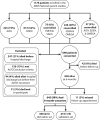Understanding patient outcomes after acute respiratory distress syndrome: identifying subtypes of physical, cognitive and mental health outcomes
- PMID: 28778920
- PMCID: PMC5690818
- DOI: 10.1136/thoraxjnl-2017-210337
Understanding patient outcomes after acute respiratory distress syndrome: identifying subtypes of physical, cognitive and mental health outcomes
Abstract
Purpose: With improving short-term mortality in acute respiratory distress syndrome (ARDS), understanding survivors' posthospitalisation outcomes is increasingly important. However, little is known regarding associations among physical, cognitive and mental health outcomes. Identification of outcome subtypes may advance understanding of post-ARDS morbidities.
Methods: We analysed baseline variables and 6-month health status for participants in the ARDS Network Long-Term Outcomes Study. After division into derivation and validation datasets, we used weighted network analysis to identify subtypes from predictors and outcomes in the derivation dataset. We then used recursive partitioning to develop a subtype classification rule and assessed adequacy of the classification rule using a kappa statistic with the validation dataset.
Results: Among 645 ARDS survivors, 430 were in the derivation and 215 in the validation datasets. Physical and mental health status, but not cognitive status, were closely associated. Four distinct subtypes were apparent (percentages in the derivation cohort): (1) mildly impaired physical and mental health (22% of patients), (2) moderately impaired physical and mental health (39%), (3) severely impaired physical health with moderately impaired mental health (15%) and (4) severely impaired physical and mental health (24%). The classification rule had high agreement (kappa=0.89 in validation dataset). Female Latino smokers had the poorest status, while male, non-Latino non-smokers had the best status.
Conclusions: We identified four post-ARDS outcome subtypes that were predicted by sex, ethnicity, pre-ARDS smoking status and other baseline factors. These subtypes may help develop tailored rehabilitation strategies, including investigation of combined physical and mental health interventions, and distinct interventions to improve cognitive outcomes.
Keywords: ARDS; health-related quality of life; mental health; outcomes; physical function; prediction.
© Article author(s) (or their employer(s) unless otherwise stated in the text of the article) 2017. All rights reserved. No commercial use is permitted unless otherwise expressly granted.
Conflict of interest statement
Competing interests: None declared.
Figures


Comment in
-
Prediction of long-term outcome subtypes in ARDS: first steps towards personalised medicine in critical care.Thorax. 2017 Dec;72(12):1067-1068. doi: 10.1136/thoraxjnl-2017-210775. Epub 2017 Oct 7. Thorax. 2017. PMID: 28988218 No abstract available.
Similar articles
-
Predictors of 6-month health utility outcomes in survivors of acute respiratory distress syndrome.Thorax. 2017 Apr;72(4):311-317. doi: 10.1136/thoraxjnl-2016-208560. Epub 2016 Jul 20. Thorax. 2017. PMID: 27440140 Free PMC article. Clinical Trial.
-
Fatigue Symptoms During the First Year Following ARDS.Chest. 2020 Sep;158(3):999-1007. doi: 10.1016/j.chest.2020.03.059. Epub 2020 Apr 15. Chest. 2020. PMID: 32304774 Free PMC article.
-
The relationship between cognitive performance and employment and health status in long-term survivors of the acute respiratory distress syndrome: results of an exploratory study.Gen Hosp Psychiatry. 2001 Mar-Apr;23(2):90-6. doi: 10.1016/s0163-8343(01)00123-2. Gen Hosp Psychiatry. 2001. PMID: 11313077
-
Recovery and outcomes after the acute respiratory distress syndrome (ARDS) in patients and their family caregivers.Intensive Care Med. 2016 May;42(5):725-738. doi: 10.1007/s00134-016-4321-8. Epub 2016 Mar 30. Intensive Care Med. 2016. PMID: 27025938 Review.
-
Improving management of ARDS: uniting acute management and long-term recovery.Crit Care. 2024 Feb 23;28(1):58. doi: 10.1186/s13054-024-04810-9. Crit Care. 2024. PMID: 38395902 Free PMC article. Review.
Cited by
-
Central Nervous System Manifestations of COVID-19: A Critical Review and Proposed Research Agenda.J Int Neuropsychol Soc. 2022 Mar;28(3):311-325. doi: 10.1017/S1355617721000345. Epub 2021 Apr 16. J Int Neuropsychol Soc. 2022. PMID: 33858556 Free PMC article. Review.
-
Spontaneous Versus Controlled Mechanical Ventilation in Patients with Acute Respiratory Distress Syndrome.Curr Anesthesiol Rep. 2021;11(2):85-91. doi: 10.1007/s40140-021-00443-8. Epub 2021 Mar 3. Curr Anesthesiol Rep. 2021. PMID: 33679255 Free PMC article. Review.
-
Good survival rate, moderate overall and good respirator quality of life, near normal pulmonary functions, and good return to work despite catastrophic economic costs 6 months following recovery from Acute Respiratory Distress Syndrome.Lung India. 2022 Mar-Apr;39(2):169-173. doi: 10.4103/lungindia.lungindia_6_21. Lung India. 2022. PMID: 35259800 Free PMC article.
-
A Research Agenda for Precision Medicine in Sepsis and Acute Respiratory Distress Syndrome: An Official American Thoracic Society Research Statement.Am J Respir Crit Care Med. 2021 Oct 15;204(8):891-901. doi: 10.1164/rccm.202108-1908ST. Am J Respir Crit Care Med. 2021. PMID: 34652268 Free PMC article.
-
Identification of three classes of acute respiratory distress syndrome using latent class analysis.PeerJ. 2018 Mar 30;6:e4592. doi: 10.7717/peerj.4592. eCollection 2018. PeerJ. 2018. PMID: 29610712 Free PMC article.
References
Publication types
MeSH terms
Grants and funding
LinkOut - more resources
Full Text Sources
Other Literature Sources
Medical
